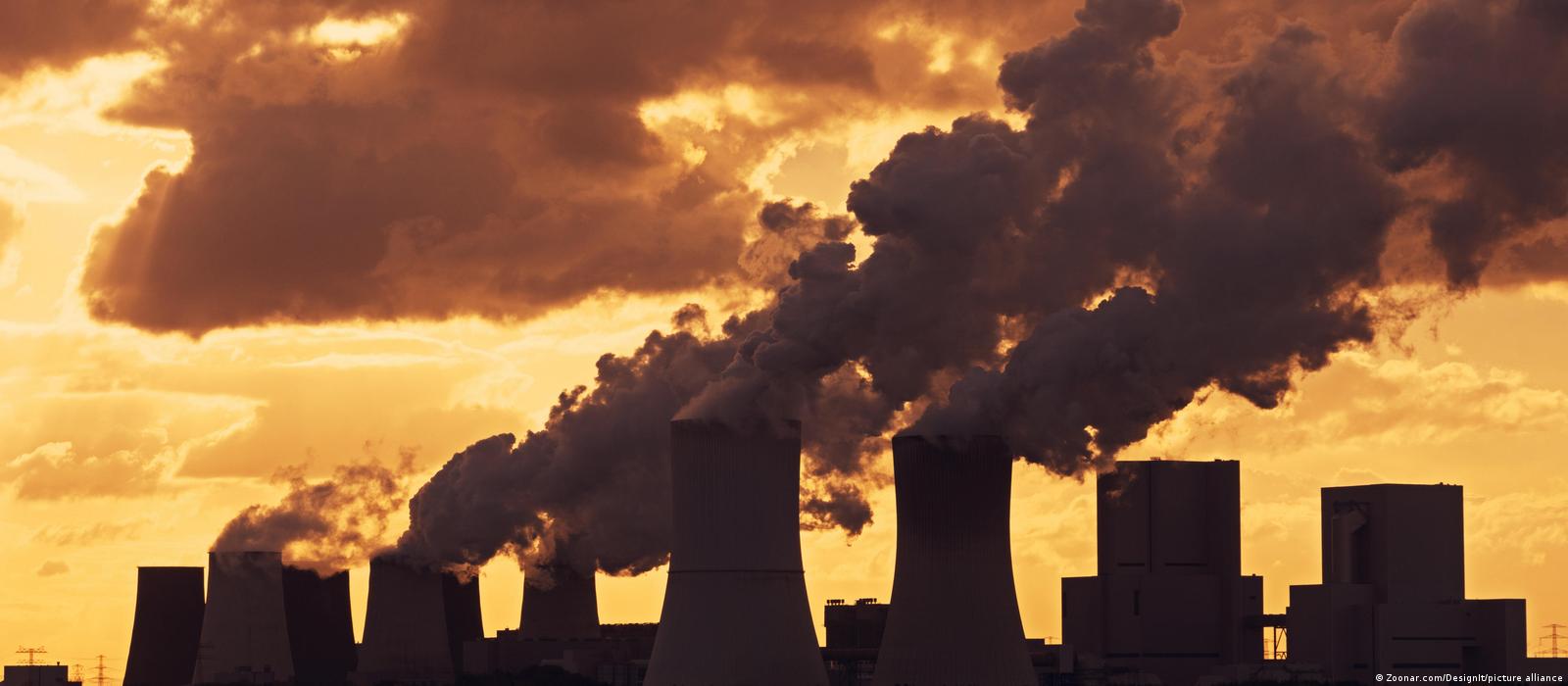
Can carbon removal help meet world's climate targets?
Martin Kuebler | Gero Rueter
DW
01/19/2023
To prevent further global heating, humans need to stop burning fossil fuels. But that's not enough — experts now say we also need to remove billions of tons of CO2 from the atmosphere. What are our options?
Humans must now start removing billions of tons of CO2 from the atmosphere alongside deep, rapid cuts in greenhouse gas emissions to keep global temperature change to well below 2 degrees Celsius (3.6 Fahrenheit) and prevent the worst effects of climate change.
"It isn't either/or," said Jan Minx of the Mercator Research Institute on Global Commons and Climate Change in Berlin, and one of the authors of a new global overview of carbon dioxide removal projects, released Thursday.
Governments around the world will need to rely on widespread deployment of established and future carbon removal technology to achieve net-zero targets by mid-century, said Minx. They will also need redouble efforts in the following decades to bring atmospheric CO2 back to climate-safe levels.
By 2100, carbon dioxide removal technology will need to extract between 450 billion and 1.1 trillion metric tons of CO2 — depending on how quickly we cut emissions over the next few decades, said the report.
"Innovation takes time, upscaling takes time, and if we don't start building these plants now and develop policy plans accordingly, then we won't get there," said Minx.
But few governments have included carbon removal projects as part of their plans to hit emissions targets, even though advances in the field have been picking up speed over the last decade, said the report, which is the first to focus on carbon removal efforts worldwide.
'Next decade is crucial' for carbon removal tech
Since 1990, we have emitted more than 924 billion metric ton of CO2 equivalent into the planet's atmosphere — more than 37 billion in 2021 alone — largely from burning climate-wrecking fossil fuels. That's more CO2 emitted in three decades than in all human history before that time.
Nearly all the world's current carbon dioxide removal — estimated at roughly 2 billion metric tons of emissions yearly — is achieved using conventional methods on managed land. This includes established methods like peatland and wetland restoration, reforestation and fixing carbon in croplands and grasslands.
A tiny fraction of 0.1% comes from new technologies like biochar, direct air carbon capture and storage, and bioenergy with carbon capture and storage.
According to the report, "the next decade is crucial" for the growth of new carbon removal technologies, comparing it to the strides made in the renewable energy sector over the last 20 years.
01/19/2023
To prevent further global heating, humans need to stop burning fossil fuels. But that's not enough — experts now say we also need to remove billions of tons of CO2 from the atmosphere. What are our options?
Humans must now start removing billions of tons of CO2 from the atmosphere alongside deep, rapid cuts in greenhouse gas emissions to keep global temperature change to well below 2 degrees Celsius (3.6 Fahrenheit) and prevent the worst effects of climate change.
"It isn't either/or," said Jan Minx of the Mercator Research Institute on Global Commons and Climate Change in Berlin, and one of the authors of a new global overview of carbon dioxide removal projects, released Thursday.
Governments around the world will need to rely on widespread deployment of established and future carbon removal technology to achieve net-zero targets by mid-century, said Minx. They will also need redouble efforts in the following decades to bring atmospheric CO2 back to climate-safe levels.
By 2100, carbon dioxide removal technology will need to extract between 450 billion and 1.1 trillion metric tons of CO2 — depending on how quickly we cut emissions over the next few decades, said the report.
"Innovation takes time, upscaling takes time, and if we don't start building these plants now and develop policy plans accordingly, then we won't get there," said Minx.
But few governments have included carbon removal projects as part of their plans to hit emissions targets, even though advances in the field have been picking up speed over the last decade, said the report, which is the first to focus on carbon removal efforts worldwide.
'Next decade is crucial' for carbon removal tech
Since 1990, we have emitted more than 924 billion metric ton of CO2 equivalent into the planet's atmosphere — more than 37 billion in 2021 alone — largely from burning climate-wrecking fossil fuels. That's more CO2 emitted in three decades than in all human history before that time.
Nearly all the world's current carbon dioxide removal — estimated at roughly 2 billion metric tons of emissions yearly — is achieved using conventional methods on managed land. This includes established methods like peatland and wetland restoration, reforestation and fixing carbon in croplands and grasslands.
A tiny fraction of 0.1% comes from new technologies like biochar, direct air carbon capture and storage, and bioenergy with carbon capture and storage.
According to the report, "the next decade is crucial" for the growth of new carbon removal technologies, comparing it to the strides made in the renewable energy sector over the last 20 years.
Biochar could help with farming
One of those developing technologies is biochar, which involves capturing the carbon absorbed by crop and forestry residue — husks, roots, bark, branches and sawdust — and other organic waste.
That waste is heated under pressure in a zero or very low oxygen environment and converted into a black powder of carbon and ash. This process fixes and stores the CO2 in a stable, solid form, preventing it from decaying naturally and releasing that carbon back into the atmosphere.
When mixed with soil, biochar can act as a fertilizer and help to increase crop yields, while also improving water retention.
Biochar has been the focus of roughly half of all research into carbon removal methods in recent years, especially in China. By 2050, global application of this technology could help remove between 0.3 and 6.6 billion metric tons of CO2 every year.
Production of biochar can, however, contribute to particulate pollution and greenhouse gas emissions through the initial heating process.
Storing CO2 underground could be key
Carbon dioxide can also be captured and stored in underground reservoirs, an expensive process that has been in limited use on Norway's oil fields since the late 20th century.
Chemical processes are used to extract the gas from the ambient air, in what's known as direct air carbon capture and storage, or DACCS. It's then compressed and stored in liquid form in vast underground reservoirs.
Swiss company Climeworks recently announced that it had successfully sequestered CO2 in basalt rock formations, where natural processes will convert it into solid carbonate rocks in roughly two years.
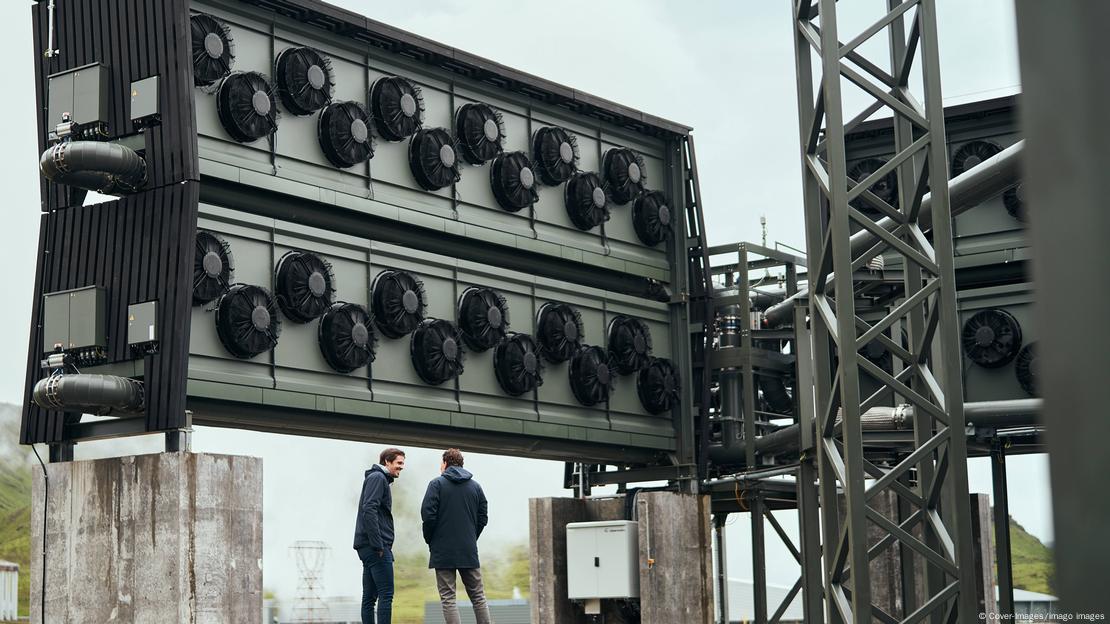
The world's largest direct air capture and storage plant recently opened in Iceland
Other DACCS pilot projects are also being developed in Canada and the United States.
Since there is no limit to the amount of CO2 that can be captured and stored, DACCS is seen as having great potential. However, the process is still controversial, as storing CO2 underground can lead to earthquakes and leakage in the long-term.
Both methods are still far from widespread use. A big disadvantage is the cost — currently anywhere between $250 and $600 (around €550) per ton, according to a recent estimate by global research non-profit, the World Resources Institute. But the WRI estimates that mass production of DACCS systems could bring prices down to between $150 and $200 per ton in the next 10 years.
Using carbon as bioenergy
Another way of removing carbon from the air involves collecting biomass — cropping and forestry leftovers, organic waste or plants grown specifically for that purpose — and burning it in a power plant to produce bioenergy. CO2 is then extracted from the exhaust gas of the power plant and stored underground. This method helps to phase out fossil fuels, while at the same time sequestering CO2.
The big problem with this technology, known as bioenergy with carbon capture and storage (BECCS), is the huge amount of space required. BECCS crops could end up competing with food crops for land and water and contribute to a loss of biodiversity and soil fertility, said the carbon removal report.
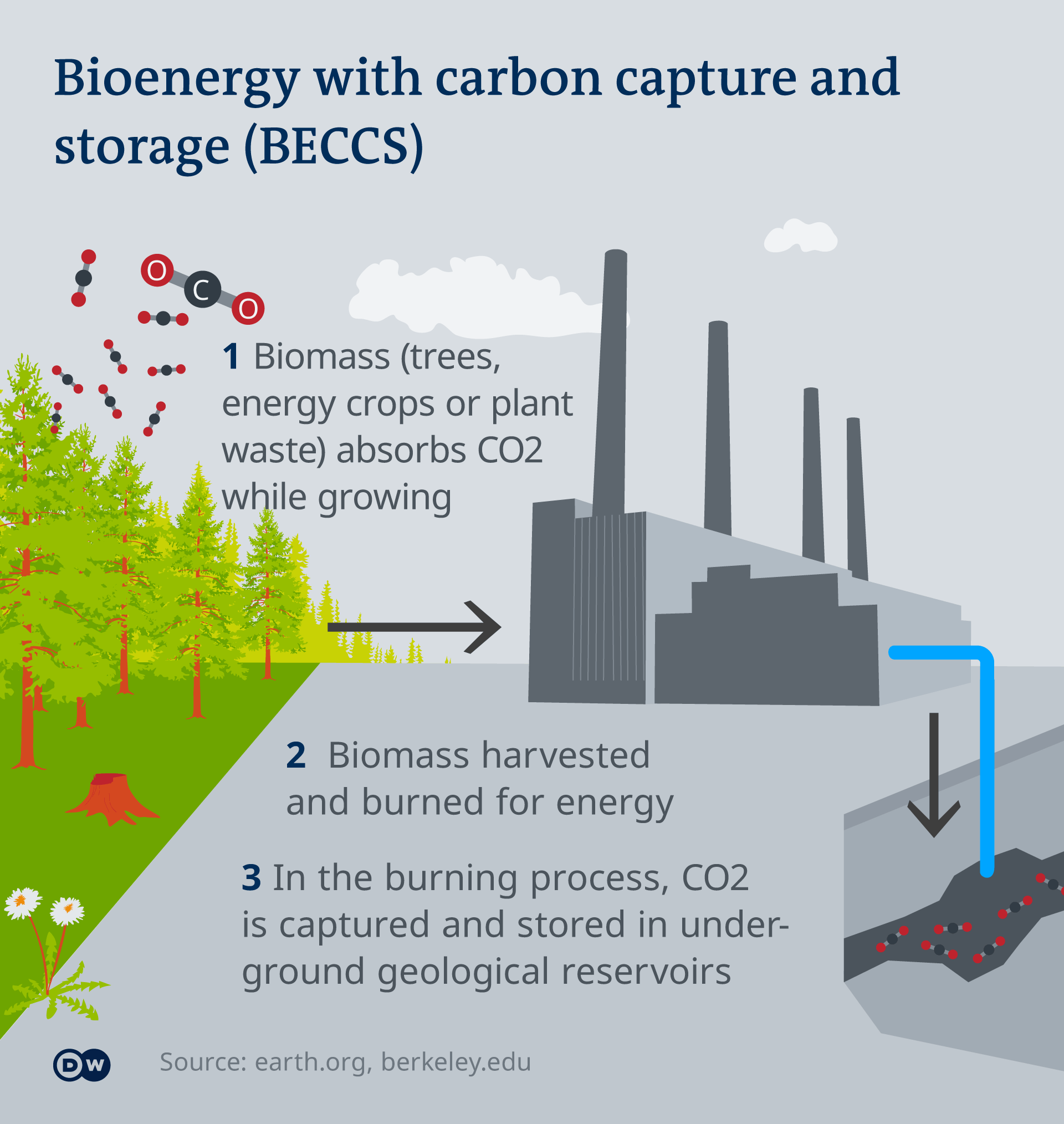
Binding CO2 to crushed rocks
In this process, called enhanced rock weathering, carbonate and silicate rocks are mined, ground and scattered on agricultural land or on the surface of the ocean. There, they mimic the natural erosion process of rain — which has absorbed CO2 as it passes through the atmosphere — and lock it away as bicarbonate. Adding the ground rocks in ocean water will theoretically increase alkalinity, increasing CO2 uptake.
Recent research suggests that by 2050, this technique could capture between 2 to 4 billion metric tons of CO2 every year. The main challenges are the destructive impact of the mining facilities, and the potential for heavy metal contamination from some rock types.
Restoring trees, soil also boosts carbon storage
Trees are a powerful natural solution to capture carbon, and if protected they can fix carbon for decades, or even centuries.
A 2019 study by the Swiss Federal Institute of Technology in Zürich found that if trees were planted around the world on an additional area of 0.9 billion hectares, they would store some 205 billion metric tons of carbon once they reach maturity.
But that's the catch — it can take many years before a tree is mature enough to absorb that much carbon. And the land area required is roughly the size of the continental US. The carbon reduction capacity of our forests could also be reduced as the effects of climate change increase, leading to more wildfires, diseases and pests.
Good news about reforestation efforts
Forests cover about one-third of the world's land area — an expanse that has been dwindling for decades. But many countries are undertaking ambitious efforts to bring back the trees.
China
Beijing has intensified decades long efforts to plant billions of trees across the country, especially in northern areas threatened by growing deserts. Every year, it plants seedlings over an area equal to Ireland. The state has pledged to boost forest coverage to 30% by 2050. Today, World Bank data say it's about 22%. But critics say non-native species and monocultures threaten water resources.
Beijing has intensified decades long efforts to plant billions of trees across the country, especially in northern areas threatened by growing deserts. Every year, it plants seedlings over an area equal to Ireland. The state has pledged to boost forest coverage to 30% by 2050. Today, World Bank data say it's about 22%. But critics say non-native species and monocultures threaten water resources.
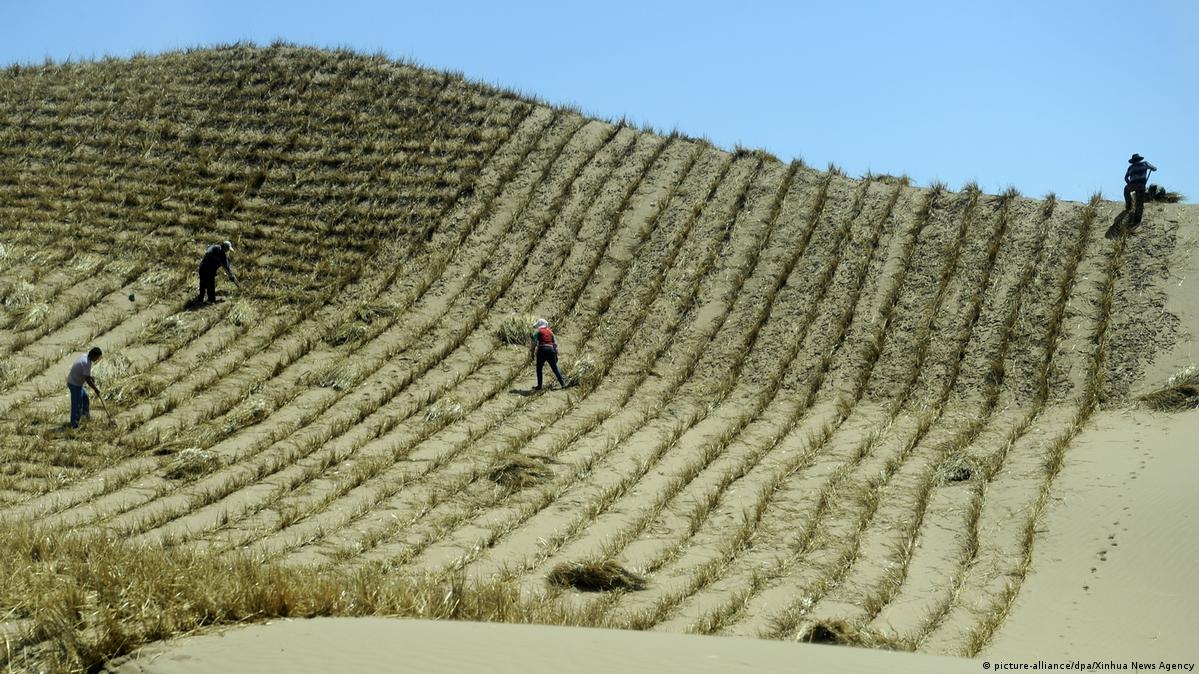
Image: picture-alliance/dpa/Xinhua News Agency
Iraq
China has also taken its expertise abroad. In Iraq, limited rain, dropping water levels, increasingly high temperatures and the volatile security situation have exacerbated desertification. Inspired by Chinese techniques, like one that uses a grid of straw squares to hold the ground together and provide a base for grasses and eventually, larger plants, experts hope to hold back the dunes.
Niger
In Africa's Sahel region, south of the Sahara, they've taken a different approach. With a variety of local vegetation and a technique that grows trees from existing root systems, local farmers have helped regreen 50,000 square kilometers (19,300 square miles) in Niger alone. This technique, developed by Australian agronomist Tony Rinaudo, was recognized with the Right Livelihood Award in 2018.I
Burkina Faso
In neighboring Burkina Faso, the UN program REDD+ helps farmers launch a large-scale tree planting effort of over 300,000 hectares (740,000 acres) to help mitigate desertification. Forests here are threatened due to expanding farms and a growing population, one of Africa's fastest. REDD+, launched in 2008, works with indigenous peoples in 65 countries in Africa, Asia-Pacific and Latin America.
India
In a country where nearly 30% of the land is degraded — by farming, urbanization and deforestation —tree planting efforts are major events. In recent years millions of Indians have joined record-breaking campaigns, planting hundreds of millions of seedling. About 40% succumb to disease or lack of water. The Modi government has pledged to restore 26 million hectares of degraded land by 2030.
Peru
The Amazon rainforest is under threat from cattle ranching and resource extraction, not to mention the devastating fires in 2019. Deforestation in Brazil rose to its highest level in over a decade last year. In neighboring Peru, reforestation efforts have targeted fields damaged by illegal gold mining, as well as the Machu Picchu archaeological site, which is at risk of mudslides and forest fires.
Australia
Australia has been ravaged by bushfires, which wiped out more than a fifth of its forests and killed some 1 billion animals. In December, the World Wide Fund for Nature launched a plan to "save and grow" 2 billion trees by 2030. "This natural climate solution can be achieved by protecting existing trees, allowing cleared forests to regenerate and planting new trees," said WWF — a boon for koalas.
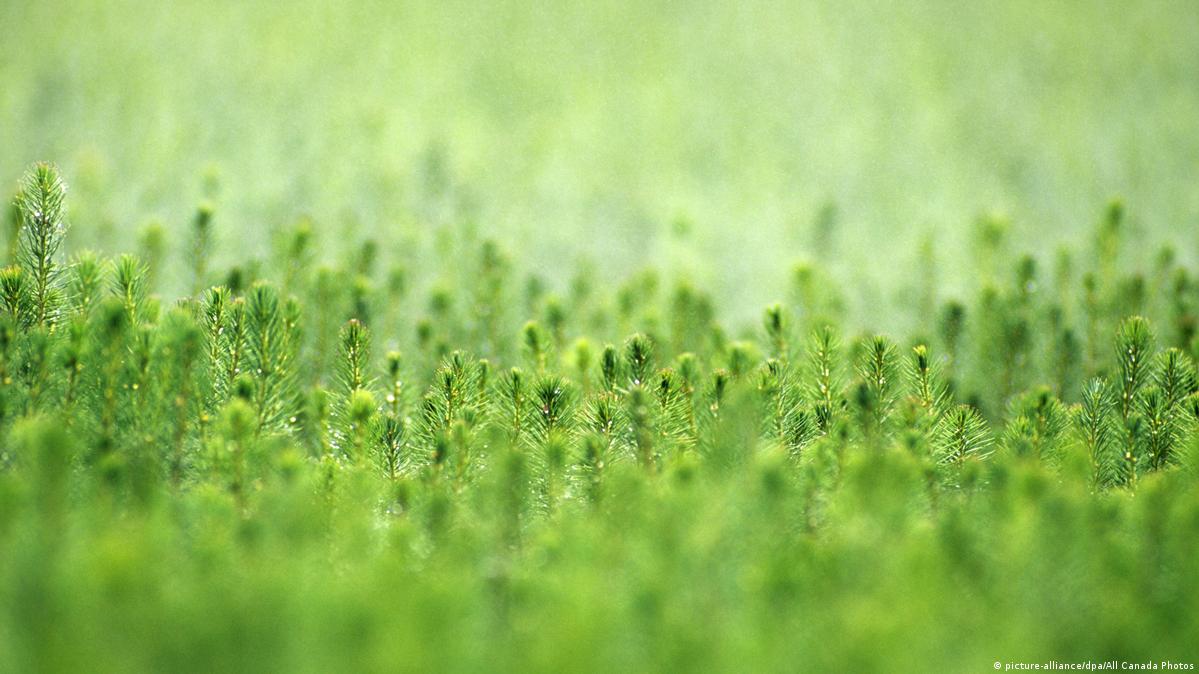
Image: picture-alliance/dpa/All Canada Photos
Canada
A tree planting veteran, Canada has been reforesting for decades — on private and public land,where laws require the forestry industry to replant following clearcutting. In his 2019 election campaign, Prime Minister Justin Trudeau committed to adding 2 billion trees over the next decade. A wide range of biomes, from Arctic tundra to temperate rainforest, makes tree selection important.
England
In northern England, trees cover just 7.6% of the countryside. But a new Northern Forest is set to take shape from western Liverpool to eastern Hull over the next 25 years. It follows the success of the National Forest further south, which saw its first saplings in 1995. It's hoped more trees will help ease climate change, reduce flooding and create jobs. But critics say it's mere greenwashing
Germany
The forests that inspired legends and fairy tales aren't doing so well. At a national forest summit last September, Berlin devoted €800 million ($878 million) to help care for and replenish the country's trees, which have suffered from several years of hot, dry weather and bark beetle attacks. Forestry experts are searching for hardy, native species which can adapt to Europe's changing climate.
Romania
Widespread illegal logging — some sourced to timber firms and furniture makers in Western Europe — is devastating some of Europe's last remaining virgin forests. Romania loses about 3-9 hectares (7-22 acres) of forest per hour to dishonest timber firms, according to Greenpeace. In early 2020, the Environment Ministry announced plans to replant more than 1,000 hectares of these affected forests.
A tree planting veteran, Canada has been reforesting for decades — on private and public land,where laws require the forestry industry to replant following clearcutting. In his 2019 election campaign, Prime Minister Justin Trudeau committed to adding 2 billion trees over the next decade. A wide range of biomes, from Arctic tundra to temperate rainforest, makes tree selection important.
England
In northern England, trees cover just 7.6% of the countryside. But a new Northern Forest is set to take shape from western Liverpool to eastern Hull over the next 25 years. It follows the success of the National Forest further south, which saw its first saplings in 1995. It's hoped more trees will help ease climate change, reduce flooding and create jobs. But critics say it's mere greenwashing
Germany
The forests that inspired legends and fairy tales aren't doing so well. At a national forest summit last September, Berlin devoted €800 million ($878 million) to help care for and replenish the country's trees, which have suffered from several years of hot, dry weather and bark beetle attacks. Forestry experts are searching for hardy, native species which can adapt to Europe's changing climate.
Romania
Widespread illegal logging — some sourced to timber firms and furniture makers in Western Europe — is devastating some of Europe's last remaining virgin forests. Romania loses about 3-9 hectares (7-22 acres) of forest per hour to dishonest timber firms, according to Greenpeace. In early 2020, the Environment Ministry announced plans to replant more than 1,000 hectares of these affected forests.
Another natural solution is humus — the dark, rich organic matter in soil formed by the decomposition of plants and animals. It also holds plenty of carbon. By planting carbon-fixing crops and adapting farming methods to leave crop residue in the soil, we can also increase the amount of CO2 stored in the ground.
In an analysis of the EU's climate policy, the German Institute for International and Security Affairs found that between 2 and 5 billion metric tons of CO2 could be sequestered by building up the world's humus.
This article was based in part on a 2020 article on carbon removal technology.
Edited by: Jennifer Collins
No comments:
Post a Comment